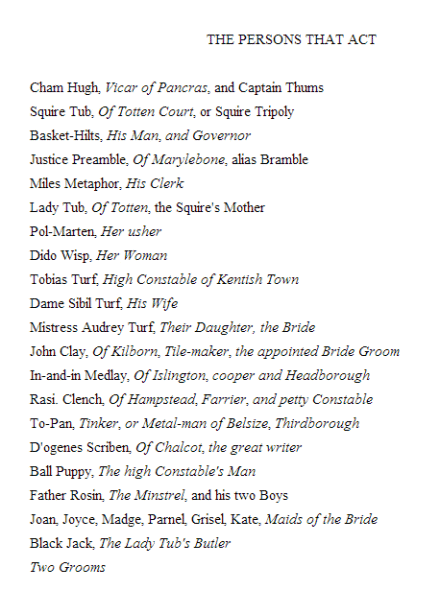Honest Ben
I’ve quickly grown to like reading Ben Jonson. He’s quite a bit of fun. As I’ve worked at parsing the allusions and piecing together the contained allegory, I’ve realized there is a dynamic quality here, and I’m using the word in the symphonic sense. When Jonson wants to be sure you get a point, or wants to be sure you know there’s a point to get, he hits you over the head with it loudly and repeatedly. At other times when the topics are sensitive, he’s writing as an author who’s spent time in jail for saying the wrong thing, those passages are quiet and heavily veiled. The loud parts are useful for us, because it’s easy to spot them and we can give them the effort they deserve, successful or not, to parse their meaning. We’ll see some examples of this right away in the Dramatis Personae of A Tale of a Tub.
click to enlarge
The Tub of the play’s title is Squire Tub. He reminds us repeatedly at the end of the play, when a masque that recaps the story is being staged, that this is his story. He is one of Audrey’s suitors. He is the principal Vere character, Vere as author of the plays. Hilts, his man, assists him in his plans to land Audrey, and he draws the Vicar in on them as well.
The name Justice Preamble should alert every Rambler reader, with its M-B-L construction. Now if you’re tempted to think nothing is made of this, his alternate name is Bramble. Like I said, when Jonson wants you to know something, he’ll loudly hit you over the head to make sure you get it. Bramble’s clerk to his machinations is Miles Metaphor. I view Bramble as Vere as intriguer. He’s there to stir the pot and cause some mayhem with his plots and devices. He’s after Audrey also, though he doesn’t express the love for her that Squire Tub has. The Vicar sees an opportunity to play one suitor against the other for profit as well.
Lady Tub is the Squire’s mother. She stands for Queen Elizabeth in my view, as the allusion is politically sensitive, it is highly veiled. Her usher, Pol-Martin is the Shaksper character in the play. Ultimately, they will be our primary focus.
There’s considerable debate as to the date of A Tale of a Tub. Some think it’s a revised early play. That debate isn’t our concern. But there is an obvious duality between an Elizabethan setting and characters and some contemporary characters that would have been recognizable to play goers in the early 1630s. In and In Medlay is a portrayal of Inigo Jones. Scriben the great writer is easily parsed as Scribe Ben, the author himself. I suspect the other members of ‘the council’, Clench and To-Pan were recognizable spoofs of Caroline era figures. An earlier version of the play contained another satirical portrayal of Jones as Vetruvius Hoop. Jones complained and the censors removed that character, though he is referenced at the end. Jones and Jonson worked together as set designer and author on many masques, but their relationship was contentious. Jonson’s distaste for Jones is obvious late in the play when In and In is staging the masque within the play for Squire Tub. There was significant topical content in this play for a 1630s audience, in addition to the then 30+ year old authorship story Jonson finally decided to tell after so much time had passed.
John Clay is Audrey’s betrothed. It is he who won the Valentine’s eve lottery and he who is to be married to her on Valentine’s day. Who does John Clay stand for in the Authorship Question? Again, when Jonson wants to make sure you know something, he’ll smack you over the head with it. Is the name Clay relevant? His full description is tile-maker. Tiles are made of clay. Clay is moldable. It can be anything. A blank slate. A tabula rasa. A blank title page. I think John Clay stands for the authorship status quo, the plays printed with blank title pages. He is the possessor of Audrey’s future at the beginning of the story. Squire Tub is plotting to change that.
more anon.
February 14, 2014 No Comments


